
By Dennis Claydon
© 1999-2009
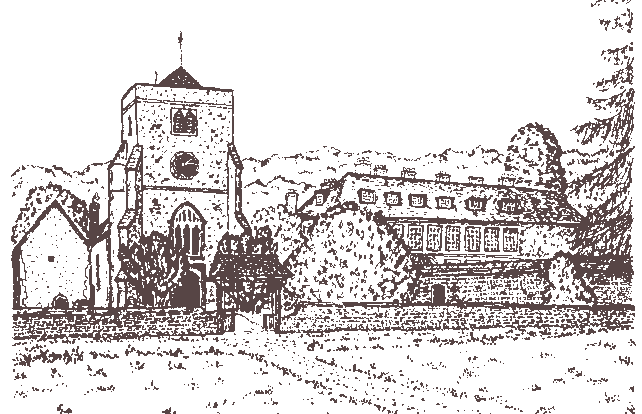
The picturesque village of Bradenham is situated four miles north-west of High Wycombe and four and a half miles south of Princes Risborough. It lies in a valley through the Chilterns, just off the main High Wycombe to Princes Risborough road.
Bradenham Woods Lane leads the visitor passed the Red Lion public house, Manor Farm and the Old Forge, a reminder of former days, to reach the spacious Village Green. The majority of the cottages, mostly constructed of brick and flint, border the northern edge of the Green. Rising gradually, the Green extends eastwards. Situated at the upper or eastern end of the Green is the Church and Manor House. Standing side by side in a prominent position, against a backcloth of beechwoods, they "preside" over the whole Village.
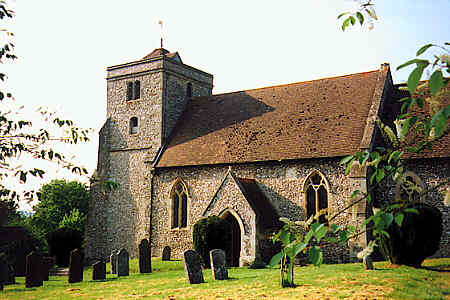
Bradenham Parish Church, St. Botolph's.
Long ago Saxon settlers made their home in this corner of the
Saunderton valley, building a Church on the current site. The name
probably derives from "Brada's homestead" or "broad valley home". By
the time of the great Domesday survey the Village was well
established, Lewin of Newenham being the landowner. Lewin's tenants,
Suarting and Herding, it is recorded, "...hold Bradenham of the
king, and are taxed for two hides of land. There is land for two
ploughs, and there are two, with two villeins. It was always valued
at twenty shillings..."
The earliest part of the present Parish Church, dedicated to St. Botolph, is the nave, dating from 1100. The southern doorway, of the same date, protected by a modern porch, is reputedly the oldest church doorway in Buckinghamshire. The remainder of the building dates from the fourteenth century onwards, the north chapel being added in 1542. A new chancel was built in 1863. The western tower, of two stages, with a clock to the west, has a turret on the northern side and diagonal buttresses. The building, of dressed flint and hewn blocks of 'Denner Hill' stone, is a fine example of the use of various local building materials.
In the medieval tower hang two of the oldest bells in England. They bear the inscription "Michael de Wymbis me fecit." The company was producing bells in Norman England and still flourished about 1300 when these were cast. It has been suggested they were not made for Bradenham, but were probably purchased second hand from another local Church. They are regarded as being two of the very few remaining bells by this founder.
The Church contains a tablet to Isaac Disraeli and his wife, both of whom lie at rest here.
The lychgate, built by Ward and Turner of Speen, was erected in honour of those of this Parish who gave their lives in the Great War, and leads from the Green into the churchyard.
Near to the south-east corner of the chancel, in the neatly maintained churchyard, is a tombstone, dated 1746, which is a listed monument. This records two noble benefactors of the Church, Edward and John Lambeth. Inside the Church is an example of their patronage, the existing altar, given by Edward in 1742.
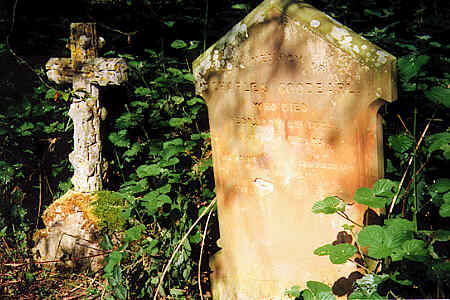
In the north-east corner of
the churchyard are a number of gravestones bearing the name of
Goodearl. These record members of this family who formerly resided
in the Village during the eighteenth century. Originally, the
surname was "Goodale", later amended to "Goodearl", an interesting
change of name. From early beginnings in Bradenham, descendants have
prospered, to become leading figures in the furniture industry in
High Wycombe and district. Two members of the family have served
High Wycombe as Mayor.
The Parish Registers, recording the "comings" and "goings" of the inhabitants of the Village, survive from 1627. In one Register the Incumbent of 1764 has recorded an event of wider interest. Such an unexpected entry is always a joy to the historian. It reads thus:
"An Earthquake happened at Oxford about fifteen minutes after four o'clock in the morning on Tuesday, sixth of November, 1764, which providentially did not occasion much damage. It was perceived at Hamden (sic) in ye County of Bucks, and in some parts of Gloucestershire. The neighbouring towns and villages near Oxon and in various parts of Berkshire and Wiltshire shook and trembled and ye foundations of Heaven moved and shook because He was wroth."
To the south of the Church stands the Manor House, with its large gardens, overlooking the cricket square on the Village Green. The western entrance gates are imposing, with accompanying railings and piers.
The present building, of red brick, tall sash windows, steep tiled roofs with small dormer windows and a row of slender brick chimneys, dates from the mid seventeenth century. This house is thought to include elements of an older, original building of 1540. The seventeenth century rebuilding was probably undertaken by Sir Edmund Pye and his wife Catherine, whose coat of arms appear inside the house.
Early in the sixteenth century Bradenham was acquired by Andrew Windsor, the son of Thomas Windsor of Stanwell. Andrew was created Lord Windsor in 1529, but died in 1543, being succeeded by his son William, the second Lord Windsor. William built the original manor house, where he resided, also adding a chapel to the Parish Church. He died in 1558 and was buried "very splendidly according to his quality" at Bradenham. Under the terms of his Will the house passed to his son Edward.
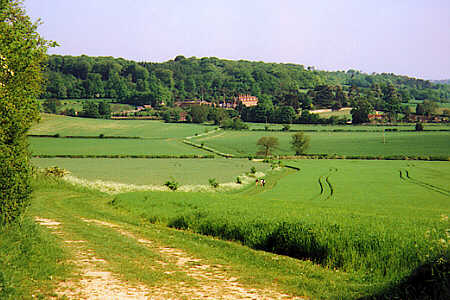
Approaching Bradenham on the track from Small Dean Lane.
Edward entertained Queen Elizabeth I in great splendour at Bradenham
in 1566, on her return from visiting the University of Oxford. A
contemporary report records the Queen staying overnight at Great
Hampden, progressing next day to Bradenham.
The route from Great Hampden brought the party through Flowers Bottom, emerging onto the ridge top at Walter's Ash. Records suggest the present Bradenham Woods Lane did not exist and the Queen's party descended down through a glade in the woodlands to reach the Manor.
This glade is still preserved. On the following day, Her Majesty set out from Bradenham "with a large party of gentlemen, because of the thieves which infested these woods." The party passed "through some of the loveliest bits of primeval forest at Walter's Ash, down Downley Common, through Tinkers Wood" to High Wycombe.
On Edward's death in 1574, Bradenham passed to his eldest son, Frederick. Edward Windsor left instructions for Frederick to build and endow almshouses, for a master and six poor men of the Parish. Strangely this bequest was never executed.
The Manor remained in the Windsor family until 1642, when it was acquired by Sir Edmund Pye. It was Sir Edmund who probably commissioned the major refurbishment of the house. For well over a century the property continued in the Pye family, until it was finally sold in 1787 to John Hicks of Plomer's Hill, Bath. On the death of John Hicks in 1825, the ownership was contested and remained for a long time in Chancery. Whilst the estate was in Chancery the Manor was leased to various tenants.
One of the better known of these tenants was Isaac Disraeli, the Father of Benjamin Disraeli. Isaac, the author of a number of notable works including "Curiosities of Literature", came to Bradenham in 1829. He is said to have enlarged and modernized the house.
Benjamin, later destined to become Prime Minister and a friend of Queen Victoria, as a young man, probably spent time at Bradenham with his father. It was the pleasant countryside around the Village which fostered his love of Buckinghamshire and the Chiltern Hills, a love which he retained throughout his life. How deeply Bradenham was fixed in his mind can be perceived by those who read his novel "Endymion", where he describes the Village under the name of "Hurstley".
Isaac died at Bradenham in 1848 and is buried in the Church. In the same year Benjamin acquired Hughenden Manor, just over the hill to the east of Bradenham, in Hughenden Valley.
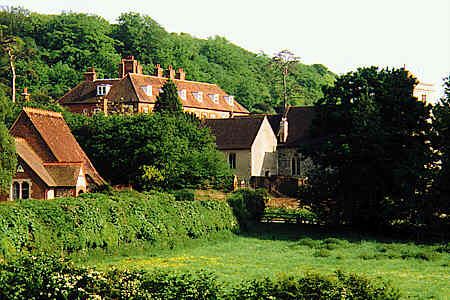
Bradenham's former school, left, which served for many years as a Youth Hostel.
Bradenham Manor is currently in use by a commercial company as a
training college and is not open to the public.
Some distance to the south-west of the Church is a house once used as the Rectory. The present building, of nineteenth century construction, marks the site of an earlier "parsonage-house". The former seven roomed dwelling, was described in 1607 as consisting of "five bays of timber, part thatched and part tiled".
Most of the present buildings in the Village, apart from the Church, date from the eighteenth century. The area around the Green has been designated a conservation area, containing no less than eighteen listed buildings. Amongst these are the Church, the Manor House, Manor Farm and its barns and the Red Lion public house.
Several cottages facing the northern edge of the Green are also included. Thift Cottage, dated 1788, retains a firemark. One pair of cottages, formerly the Village store and post office, bear a plaque in recognition of the family of long serving proprietors. The White House, with its granary and timbered outbuildings, has an unusual battlemented parapet to the front. This is a nineteenth century addition to an eighteenth century building. Close by, beside a small pond, is the former Village School, became a Youth Hostel and is now being converted to a private dwelling.
An eighteenth century report on Bradenham reveals the Parish contained one thousand two hundred and fifty acres. Seventy acres were under pasture with eight hundred and eighty acres being used for arable. A further three hundred acres were woodland. There were thirty six families living in the Parish, the total estimated number of inhabitants being about two hundred.
The northern edge of the Green is lined with lumps of "Puddingstone". Pieces of this naturally occurring rock are to be found dispersed throughout the locality. Another stone typical of the Chilterns, "Sarsen" sandstone, is interspersed with the pudding stones. An Ice Age sarsen stone, unearthed in Great Close Field, has been erected by Bradenham Parish Council on the Green, to commemorate the dawn of the third Millennium.
North-eastwards of the Church, in a small meadow beside Bradenham Woods Lane, shaded by overhanging beechwoods, is an unusual feature of the landscape. Scattered across the meadow, like a miniature Stonehenge or Avebury Circle, are a series of stones and boulders of various shapes and sizes. These stones, however, although far older than the Village of Bradenham itself, are not the work of some long lost civilisation. Experts agree they are a curious feat of nature, produced by a deposit left behind from the days of the great Ice Age.
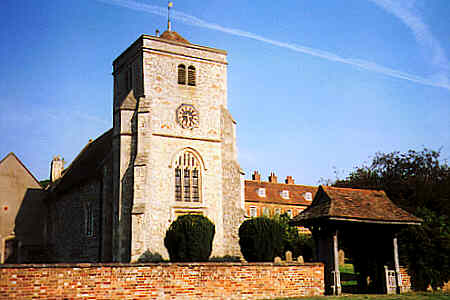
The Church with the Manor beyond.
The reason that Bradenham remains genuinely unspoiled, is probably
due largely to the fact that much of the Village, including the
surrounding woodland, is cared for by the National Trust.
The one thousand one hundred and eleven acre estate, was acquired in 1956, under the Will of the late Ernest E. Cook Esq. It included the Manor House, the Red Lion, farmland and three hundred and eighty acres of woodland. Currently there are about six hundred acres of farmland, mostly arable, forming around two thirds of the estate.
The National Trust has carried out an archaeological survey of the area, the results of which give a fascinating glimpse into Bradenham's past.
Long straight boundary ditches are to be found within the woodlands. These suggest that two thousand years BC the hilltops may have been treeless.
In arable land to the north of the Village are Bronze Age barrows. These now only show as crop markings.
There is evidence of late Iron Age/early Roman field systems, indicated by step-like features. Iron slag, a by product of iron smelting has been found, proving there was industry here in Roman times. Some woodlands have not been disturbed for two thousand years and field boundaries still survive.
By the twelfth century the Village had a Church and possibly a first manor house. The main settlement grew up around these. The Green once formed part of Bradenham Commons, used for grazing and the gathering of firewood. Within living memory the Green has been used for grazing.
Park Wood, to the north-east, was formerly a Tudor deer park which provided sport and meat. By the eighteenth century this had been abandoned, part of the woodland being used as a field. In the late nineteenth century this once again returned to woodland.
To the east is The Coppice. This was originally a mixed woodland of ash, hazel and other native trees. The timber may have been used for small craft work, but was principally for firewood. It was converted into beechwoods, to cater for the High Wycombe furniture industry, during the late eighteenth and the early nineteenth century.
Some hedges on the estate may be more than a thousand years old. They often marked Parish boundaries.
Two sections of the mysterious earthwork, known as Grims Ditch, appear in Park Wood and Beamangreen Wood, to the north-east. This curious feature can be traced, at intervals, across the Chiltern Hills. Commencing at Bradenham it heads north-eastwards, via Lacey Green and Great Hampden to Berkhamsted, a distance of sixteen miles. The purpose of the Ditch is unknown, but it is thought probably to be some kind of boundary mark. It has been proved to be of Iron Age origin.
Consideration is being given to the return of some arable land to woodland, following lines of old estate maps. Plans are also being considered for the restoration of the Manor gardens, to reflect their appearance in Disraeli's day.
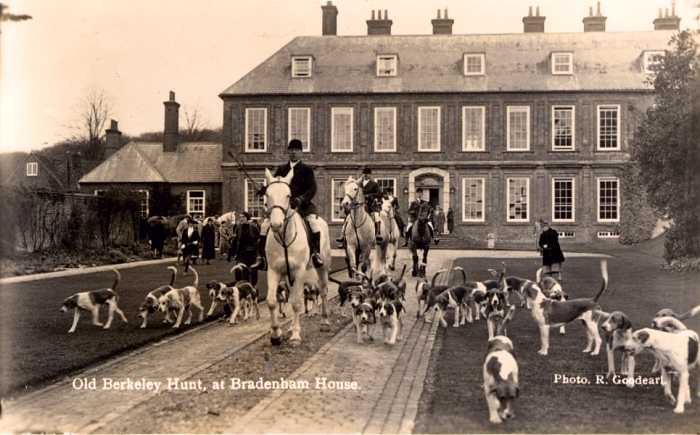 The Old Berkeley Hunt at Bradenham Manor. A postcard by Ronald Goodearl.
The Old Berkeley Hunt at Bradenham Manor. A postcard by Ronald Goodearl.
A series of public footpaths radiate from the Village Green.
(a) From the free car park, in the south-east corner of the Green,
continue uphill, along the track beside the southern garden wall
of the Manor into Bradenham Wood. This Wood has been designated
a Site of Special Scientific Interest.
(b) Follow the path opposite the church, next to the former Youth Hostel,
across open fields towards Park Wood and Small Dean.
(c) Follow the path on the far side of the A4010, opposite the Red
Lion. Crossing the railway line with care, continue climbing the
hillside to gain the summit of the adjacent ridge.
Each of the above provides a different aspect of the Village of
Bradenham, together with fine views of the surrounding countryside.
An Autumn walk through the woods from Bradenham to West Wycombe
Lacey Green, nearby village on the hill. Local history and walks (This website's home page)
Ken's Goodearl family pages and local history in the Wycombe area
Many more Photos of Buckinghamshire and Beyond